Compared to other countries, the United States system of healthcare is considered to be complex. The U.S. does not provide universal healthcare for its citizens. Instead, there are a number of private and public institutions in place which pay for the healthcare of U.S. citizens. This post will provide a basic understanding of the U.S. healthcare system for those interested in practicing medicine in the U.S.
While the U.S. does not have a national healthcare system, there are private and public options. For those who can afford private healthcare, health insurance is an option. Health insurance companies are considered payers. They pay for the healthcare of the insured. Insurance companies have networks of physicians, hospitals, and clinics which subsidize payments for the insured.
On a healthcare insurance plan, people pay a fee each month to ensure coverage while the insurance company pays for the rest. Visiting a doctor that is not included in the insurance network might require you to pay more out-of-pocket. Physicians, hospitals, and clinics are paid through the insurance companies. Often, there is a lot of documentation involved. Health insurance ensures people can go to the doctor, receive preventative or emergency care whenever they need it at a reasonable cost.
Many employers provide health insurance for their employees. Employers can subsidize the cost of a plan or pay for it in full.
While there is a large population of Americans who have private insurance, there are still many without access to health insurance. According to the 2007 U.S Census, almost 46 million people lack health insurance. Government-funded programs like Medicare and Medicaid provide funding for these individuals although coverage and options may be less extensive when compared to that of private insurance plans.
30% of the population is covered by Medicare and Medicaid programs. Medicare is a national, government-funded social insurance program for seniors 65 years old or older and for some people with disabilities. Medicaid is a state-based insurance program for people with low income.
Medicare consists of four parts: A, B, C, and D. Medicare Part A provides hospital insurance. Medicare Part B provides medical insurance. Medicare Part C is a private insurance option where private companies offer services approved by Medicare. Medicare Part D is an outpatient prescription drug program that subsidizes payment. People can opt in or out of the different parts depending on their needs.
Medicaid is partially funded by the federal government and states. While the federal government sets broad standards for Medicaid, states have control over eligibility. The services provided by Medicaid vary.
While the U.S. healthcare system is complex, an awareness of its institutions and players is key to understanding the dynamics. IMGs can read up on the healthcare system before coming to the U.S. to understand what to expect in their U.S. clinical experience.
Want to learn about the US healthcare system first hand? Apply for a clinical rotation with AMO today!







I would like to know more information
Hello Jaqueline,
Thanks for the comment. To learn more about AMO click here.
If you would like to discuss taking part in a clinical rotation with an AMO advisor, they can be reached through email at support@amopportunities.org.
Regards,
Stephanie